Research: NZ Customer Perception of Nestle Baby Food Nanoparticles
VerifiedAdded on 2021/06/15
|22
|6486
|126
Report
AI Summary
This report examines the perceptions of New Zealand customers regarding the presence of toxic nanoparticles in Nestle's baby food formulas. The research explores the controversy surrounding the use of nanotechnology and hydroxyapatite in infant formulas, following the discovery of potentially harmful needle-shaped nanoparticles by Friends of the Earth. The report details the findings of interviews with six mothers, revealing concerns about the safety of these formulas and the potential impact on their children's health, despite FSANZ's stance that the formulas are safe. It delves into the use of nanotechnology in food processing and packaging, the regulatory frameworks in place to ensure food safety, and the limitations of the research, including the small sample size and the reliance on secondary data. The conclusion offers recommendations on how Nestle can regain consumer trust by addressing these concerns and providing transparent information about its products. The report also includes an overview of how baby food is prepared, the role of nanotechnology in food safety, and the regulations governing its use in Australia and New Zealand.
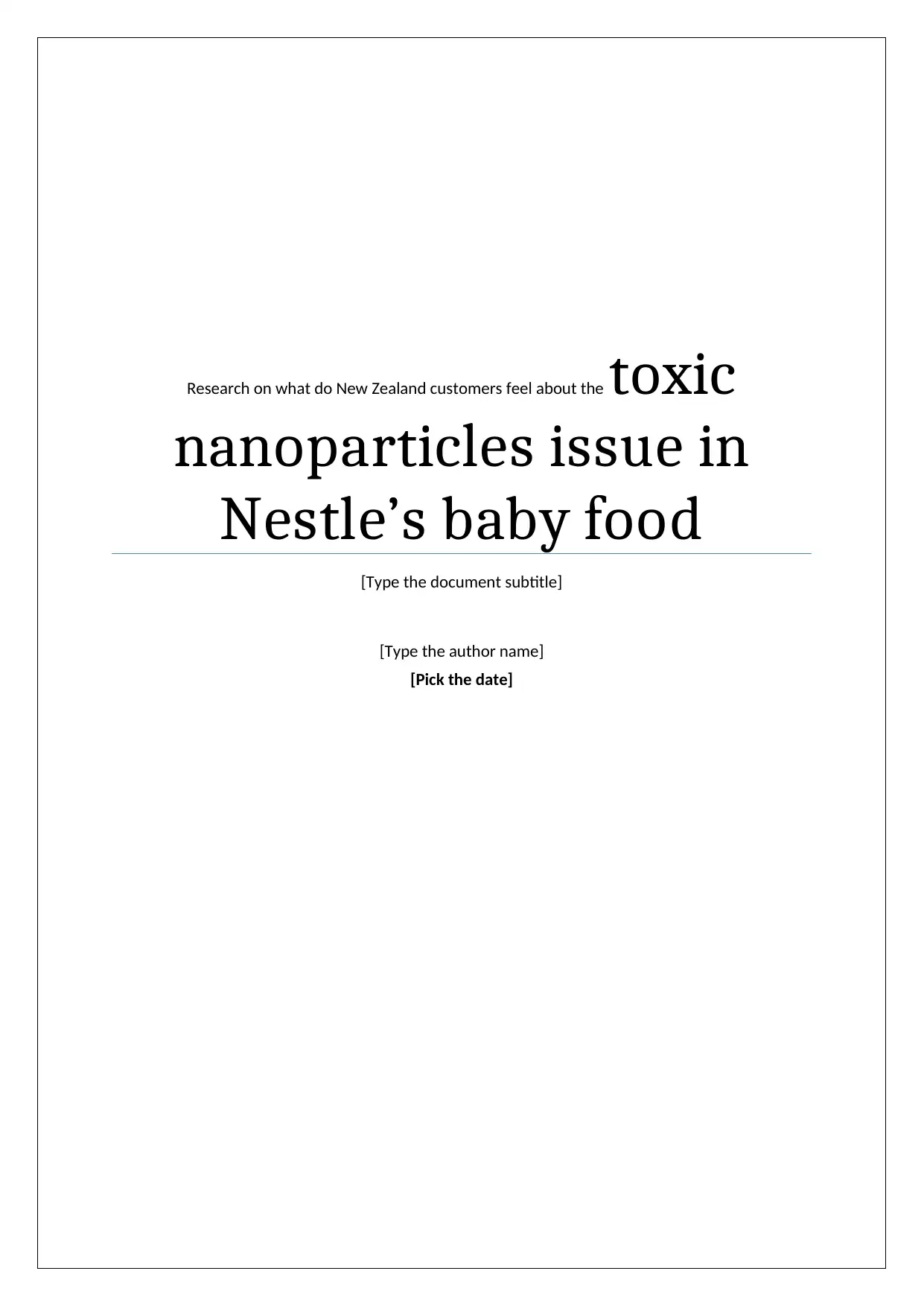
Research on what do New Zealand customers feel about the toxic
nanoparticles issue in
Nestle’s baby food
[Type the document subtitle]
[Type the author name]
[Pick the date]
nanoparticles issue in
Nestle’s baby food
[Type the document subtitle]
[Type the author name]
[Pick the date]
Paraphrase This Document
Need a fresh take? Get an instant paraphrase of this document with our AI Paraphraser
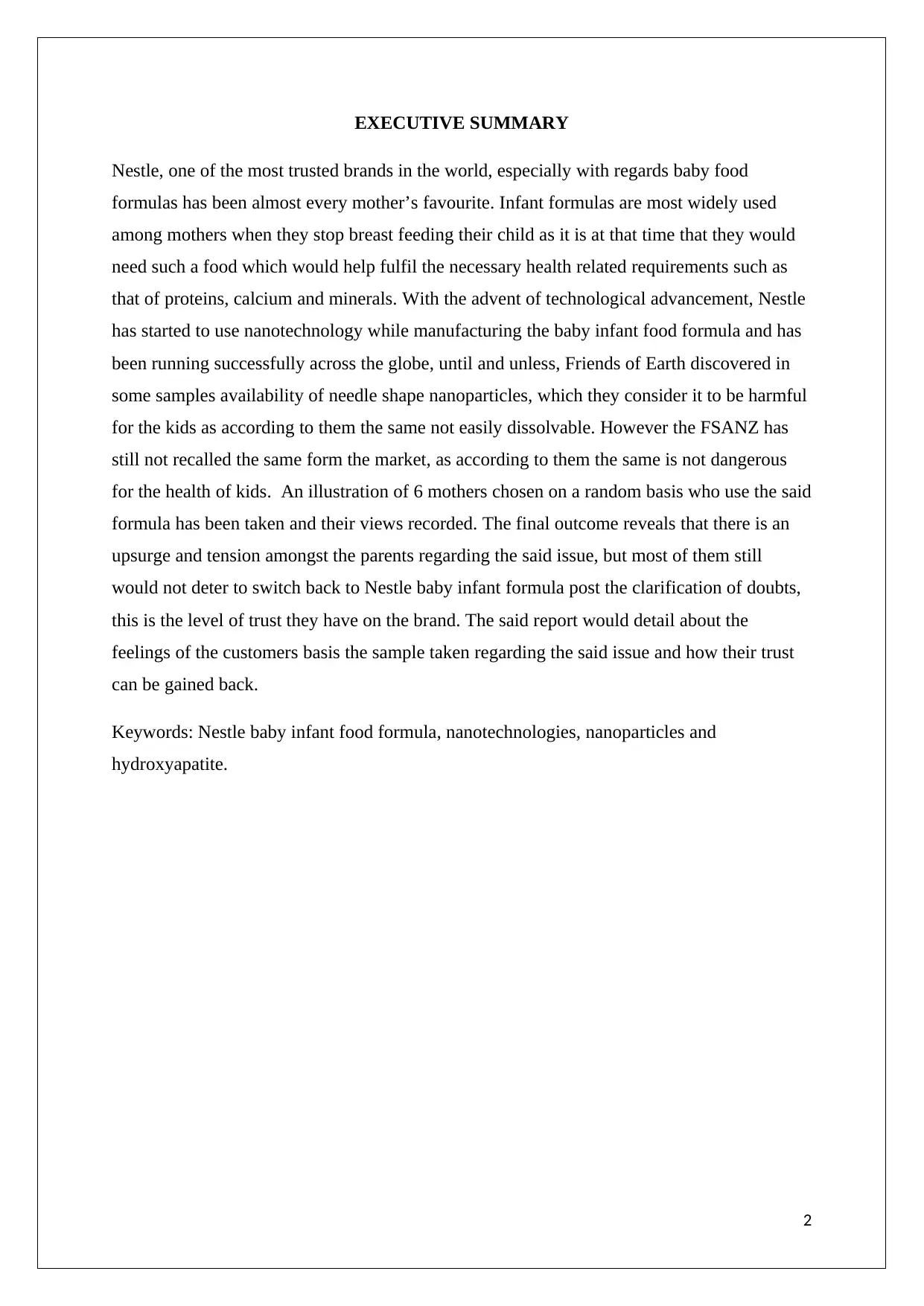
EXECUTIVE SUMMARY
Nestle, one of the most trusted brands in the world, especially with regards baby food
formulas has been almost every mother’s favourite. Infant formulas are most widely used
among mothers when they stop breast feeding their child as it is at that time that they would
need such a food which would help fulfil the necessary health related requirements such as
that of proteins, calcium and minerals. With the advent of technological advancement, Nestle
has started to use nanotechnology while manufacturing the baby infant food formula and has
been running successfully across the globe, until and unless, Friends of Earth discovered in
some samples availability of needle shape nanoparticles, which they consider it to be harmful
for the kids as according to them the same not easily dissolvable. However the FSANZ has
still not recalled the same form the market, as according to them the same is not dangerous
for the health of kids. An illustration of 6 mothers chosen on a random basis who use the said
formula has been taken and their views recorded. The final outcome reveals that there is an
upsurge and tension amongst the parents regarding the said issue, but most of them still
would not deter to switch back to Nestle baby infant formula post the clarification of doubts,
this is the level of trust they have on the brand. The said report would detail about the
feelings of the customers basis the sample taken regarding the said issue and how their trust
can be gained back.
Keywords: Nestle baby infant food formula, nanotechnologies, nanoparticles and
hydroxyapatite.
2
Nestle, one of the most trusted brands in the world, especially with regards baby food
formulas has been almost every mother’s favourite. Infant formulas are most widely used
among mothers when they stop breast feeding their child as it is at that time that they would
need such a food which would help fulfil the necessary health related requirements such as
that of proteins, calcium and minerals. With the advent of technological advancement, Nestle
has started to use nanotechnology while manufacturing the baby infant food formula and has
been running successfully across the globe, until and unless, Friends of Earth discovered in
some samples availability of needle shape nanoparticles, which they consider it to be harmful
for the kids as according to them the same not easily dissolvable. However the FSANZ has
still not recalled the same form the market, as according to them the same is not dangerous
for the health of kids. An illustration of 6 mothers chosen on a random basis who use the said
formula has been taken and their views recorded. The final outcome reveals that there is an
upsurge and tension amongst the parents regarding the said issue, but most of them still
would not deter to switch back to Nestle baby infant formula post the clarification of doubts,
this is the level of trust they have on the brand. The said report would detail about the
feelings of the customers basis the sample taken regarding the said issue and how their trust
can be gained back.
Keywords: Nestle baby infant food formula, nanotechnologies, nanoparticles and
hydroxyapatite.
2
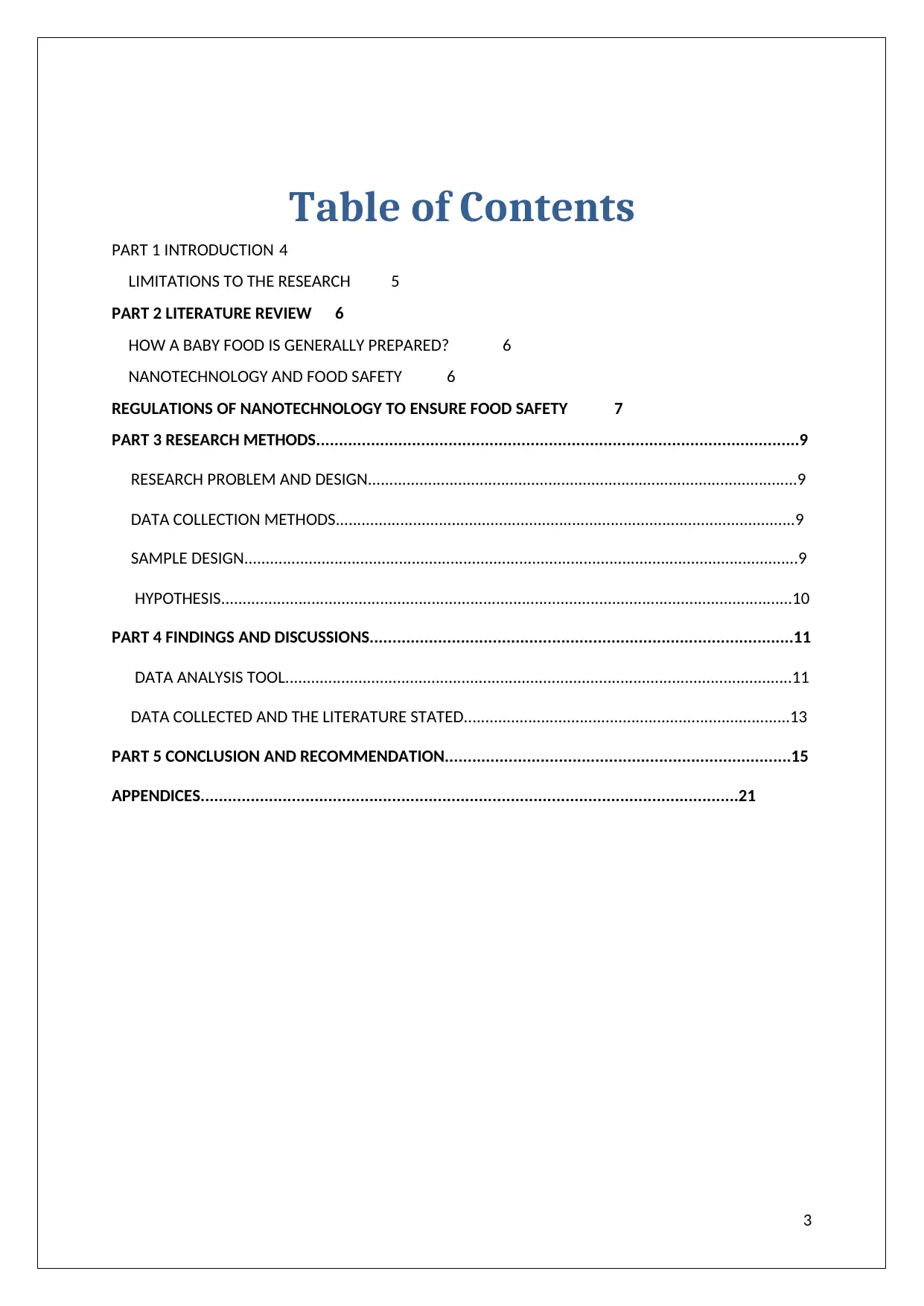
Table of Contents
PART 1 INTRODUCTION 4
LIMITATIONS TO THE RESEARCH 5
PART 2 LITERATURE REVIEW 6
HOW A BABY FOOD IS GENERALLY PREPARED? 6
NANOTECHNOLOGY AND FOOD SAFETY 6
REGULATIONS OF NANOTECHNOLOGY TO ENSURE FOOD SAFETY 7
PART 3 RESEARCH METHODS..........................................................................................................9
RESEARCH PROBLEM AND DESIGN....................................................................................................9
DATA COLLECTION METHODS...........................................................................................................9
SAMPLE DESIGN.................................................................................................................................9
HYPOTHESIS.....................................................................................................................................10
PART 4 FINDINGS AND DISCUSSIONS.............................................................................................11
DATA ANALYSIS TOOL......................................................................................................................11
DATA COLLECTED AND THE LITERATURE STATED............................................................................13
PART 5 CONCLUSION AND RECOMMENDATION............................................................................15
APPENDICES......................................................................................................................21
3
PART 1 INTRODUCTION 4
LIMITATIONS TO THE RESEARCH 5
PART 2 LITERATURE REVIEW 6
HOW A BABY FOOD IS GENERALLY PREPARED? 6
NANOTECHNOLOGY AND FOOD SAFETY 6
REGULATIONS OF NANOTECHNOLOGY TO ENSURE FOOD SAFETY 7
PART 3 RESEARCH METHODS..........................................................................................................9
RESEARCH PROBLEM AND DESIGN....................................................................................................9
DATA COLLECTION METHODS...........................................................................................................9
SAMPLE DESIGN.................................................................................................................................9
HYPOTHESIS.....................................................................................................................................10
PART 4 FINDINGS AND DISCUSSIONS.............................................................................................11
DATA ANALYSIS TOOL......................................................................................................................11
DATA COLLECTED AND THE LITERATURE STATED............................................................................13
PART 5 CONCLUSION AND RECOMMENDATION............................................................................15
APPENDICES......................................................................................................................21
3
⊘ This is a preview!⊘
Do you want full access?
Subscribe today to unlock all pages.

Trusted by 1+ million students worldwide
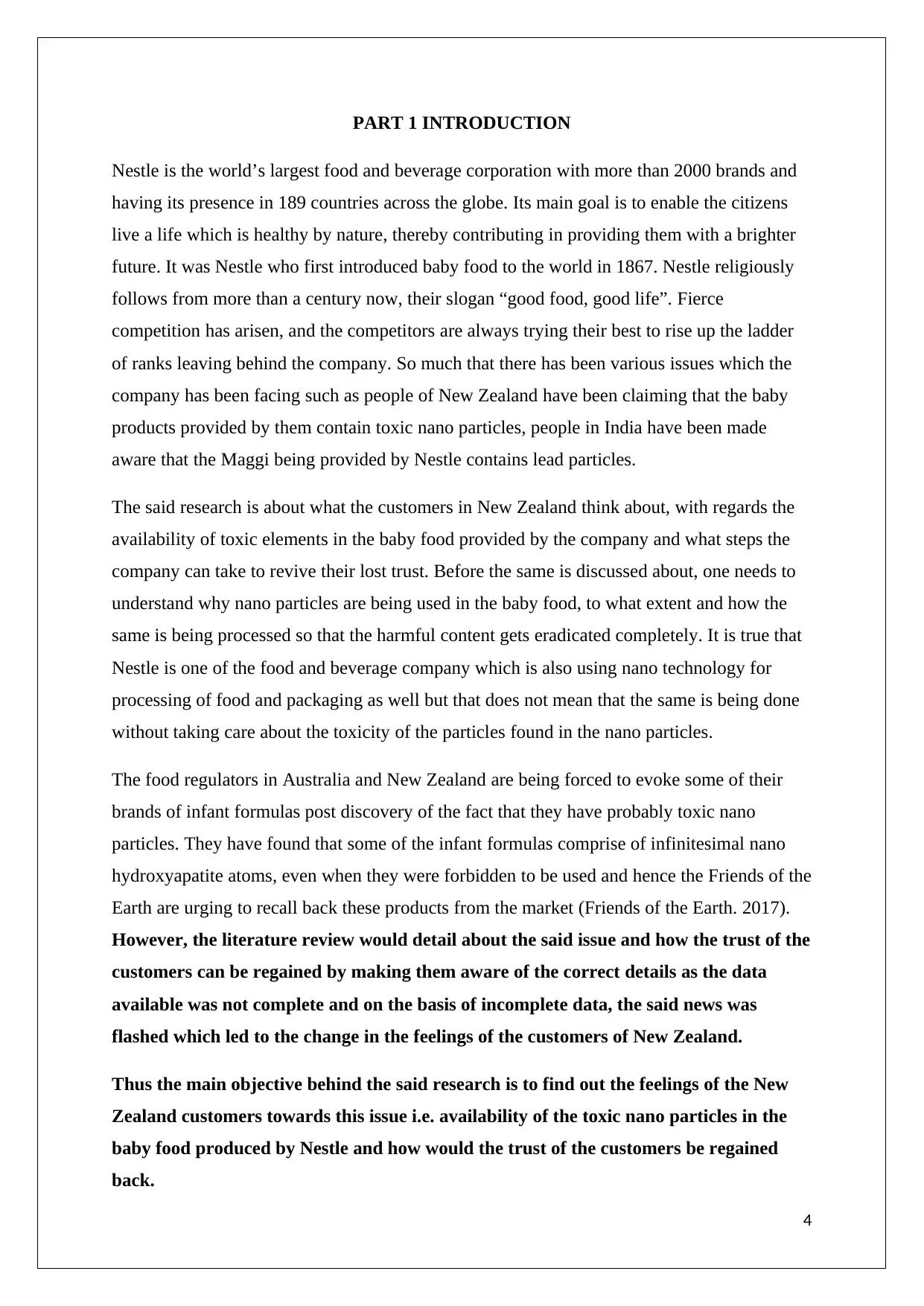
PART 1 INTRODUCTION
Nestle is the world’s largest food and beverage corporation with more than 2000 brands and
having its presence in 189 countries across the globe. Its main goal is to enable the citizens
live a life which is healthy by nature, thereby contributing in providing them with a brighter
future. It was Nestle who first introduced baby food to the world in 1867. Nestle religiously
follows from more than a century now, their slogan “good food, good life”. Fierce
competition has arisen, and the competitors are always trying their best to rise up the ladder
of ranks leaving behind the company. So much that there has been various issues which the
company has been facing such as people of New Zealand have been claiming that the baby
products provided by them contain toxic nano particles, people in India have been made
aware that the Maggi being provided by Nestle contains lead particles.
The said research is about what the customers in New Zealand think about, with regards the
availability of toxic elements in the baby food provided by the company and what steps the
company can take to revive their lost trust. Before the same is discussed about, one needs to
understand why nano particles are being used in the baby food, to what extent and how the
same is being processed so that the harmful content gets eradicated completely. It is true that
Nestle is one of the food and beverage company which is also using nano technology for
processing of food and packaging as well but that does not mean that the same is being done
without taking care about the toxicity of the particles found in the nano particles.
The food regulators in Australia and New Zealand are being forced to evoke some of their
brands of infant formulas post discovery of the fact that they have probably toxic nano
particles. They have found that some of the infant formulas comprise of infinitesimal nano
hydroxyapatite atoms, even when they were forbidden to be used and hence the Friends of the
Earth are urging to recall back these products from the market (Friends of the Earth. 2017).
However, the literature review would detail about the said issue and how the trust of the
customers can be regained by making them aware of the correct details as the data
available was not complete and on the basis of incomplete data, the said news was
flashed which led to the change in the feelings of the customers of New Zealand.
Thus the main objective behind the said research is to find out the feelings of the New
Zealand customers towards this issue i.e. availability of the toxic nano particles in the
baby food produced by Nestle and how would the trust of the customers be regained
back.
4
Nestle is the world’s largest food and beverage corporation with more than 2000 brands and
having its presence in 189 countries across the globe. Its main goal is to enable the citizens
live a life which is healthy by nature, thereby contributing in providing them with a brighter
future. It was Nestle who first introduced baby food to the world in 1867. Nestle religiously
follows from more than a century now, their slogan “good food, good life”. Fierce
competition has arisen, and the competitors are always trying their best to rise up the ladder
of ranks leaving behind the company. So much that there has been various issues which the
company has been facing such as people of New Zealand have been claiming that the baby
products provided by them contain toxic nano particles, people in India have been made
aware that the Maggi being provided by Nestle contains lead particles.
The said research is about what the customers in New Zealand think about, with regards the
availability of toxic elements in the baby food provided by the company and what steps the
company can take to revive their lost trust. Before the same is discussed about, one needs to
understand why nano particles are being used in the baby food, to what extent and how the
same is being processed so that the harmful content gets eradicated completely. It is true that
Nestle is one of the food and beverage company which is also using nano technology for
processing of food and packaging as well but that does not mean that the same is being done
without taking care about the toxicity of the particles found in the nano particles.
The food regulators in Australia and New Zealand are being forced to evoke some of their
brands of infant formulas post discovery of the fact that they have probably toxic nano
particles. They have found that some of the infant formulas comprise of infinitesimal nano
hydroxyapatite atoms, even when they were forbidden to be used and hence the Friends of the
Earth are urging to recall back these products from the market (Friends of the Earth. 2017).
However, the literature review would detail about the said issue and how the trust of the
customers can be regained by making them aware of the correct details as the data
available was not complete and on the basis of incomplete data, the said news was
flashed which led to the change in the feelings of the customers of New Zealand.
Thus the main objective behind the said research is to find out the feelings of the New
Zealand customers towards this issue i.e. availability of the toxic nano particles in the
baby food produced by Nestle and how would the trust of the customers be regained
back.
4
Paraphrase This Document
Need a fresh take? Get an instant paraphrase of this document with our AI Paraphraser
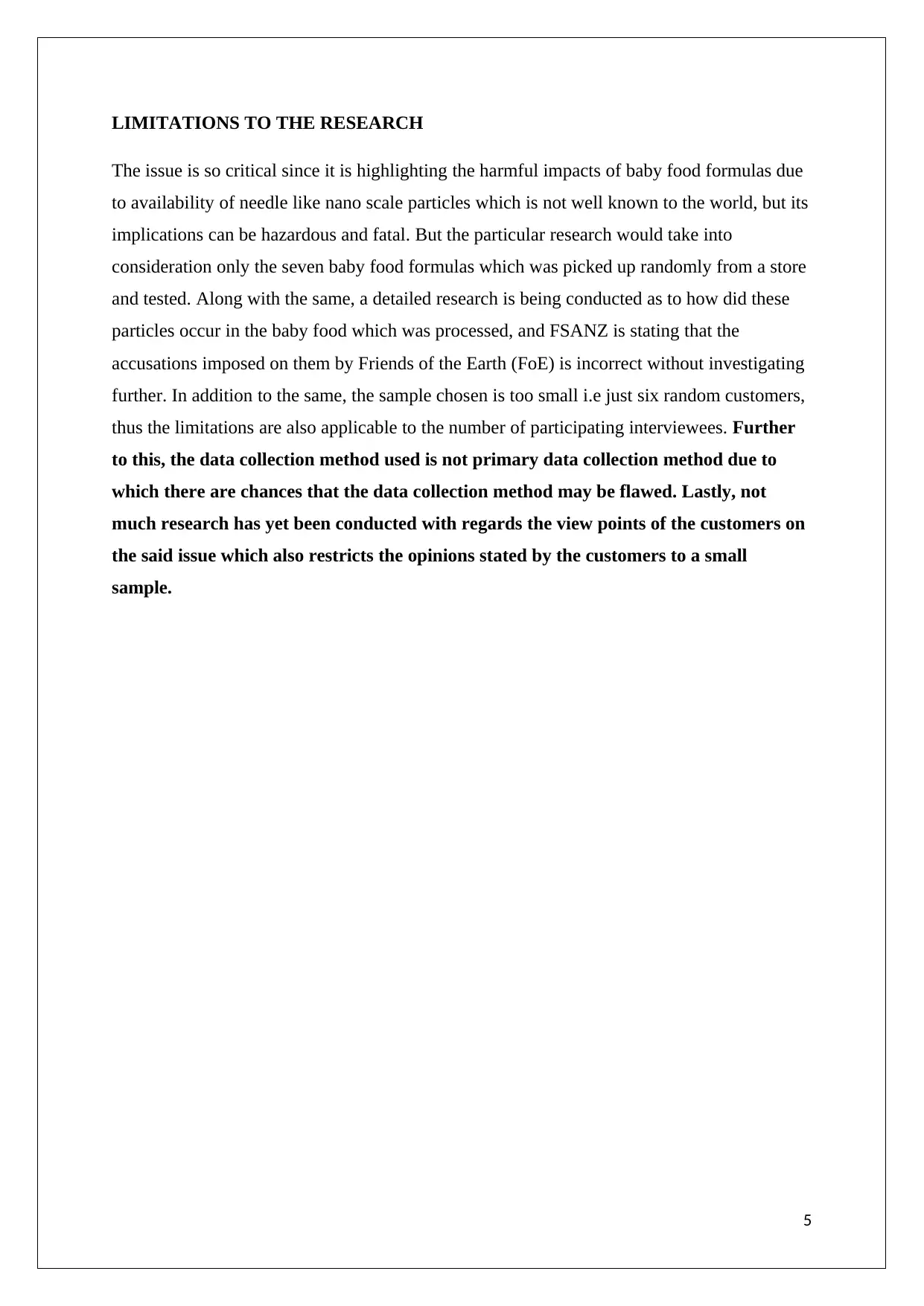
LIMITATIONS TO THE RESEARCH
The issue is so critical since it is highlighting the harmful impacts of baby food formulas due
to availability of needle like nano scale particles which is not well known to the world, but its
implications can be hazardous and fatal. But the particular research would take into
consideration only the seven baby food formulas which was picked up randomly from a store
and tested. Along with the same, a detailed research is being conducted as to how did these
particles occur in the baby food which was processed, and FSANZ is stating that the
accusations imposed on them by Friends of the Earth (FoE) is incorrect without investigating
further. In addition to the same, the sample chosen is too small i.e just six random customers,
thus the limitations are also applicable to the number of participating interviewees. Further
to this, the data collection method used is not primary data collection method due to
which there are chances that the data collection method may be flawed. Lastly, not
much research has yet been conducted with regards the view points of the customers on
the said issue which also restricts the opinions stated by the customers to a small
sample.
5
The issue is so critical since it is highlighting the harmful impacts of baby food formulas due
to availability of needle like nano scale particles which is not well known to the world, but its
implications can be hazardous and fatal. But the particular research would take into
consideration only the seven baby food formulas which was picked up randomly from a store
and tested. Along with the same, a detailed research is being conducted as to how did these
particles occur in the baby food which was processed, and FSANZ is stating that the
accusations imposed on them by Friends of the Earth (FoE) is incorrect without investigating
further. In addition to the same, the sample chosen is too small i.e just six random customers,
thus the limitations are also applicable to the number of participating interviewees. Further
to this, the data collection method used is not primary data collection method due to
which there are chances that the data collection method may be flawed. Lastly, not
much research has yet been conducted with regards the view points of the customers on
the said issue which also restricts the opinions stated by the customers to a small
sample.
5
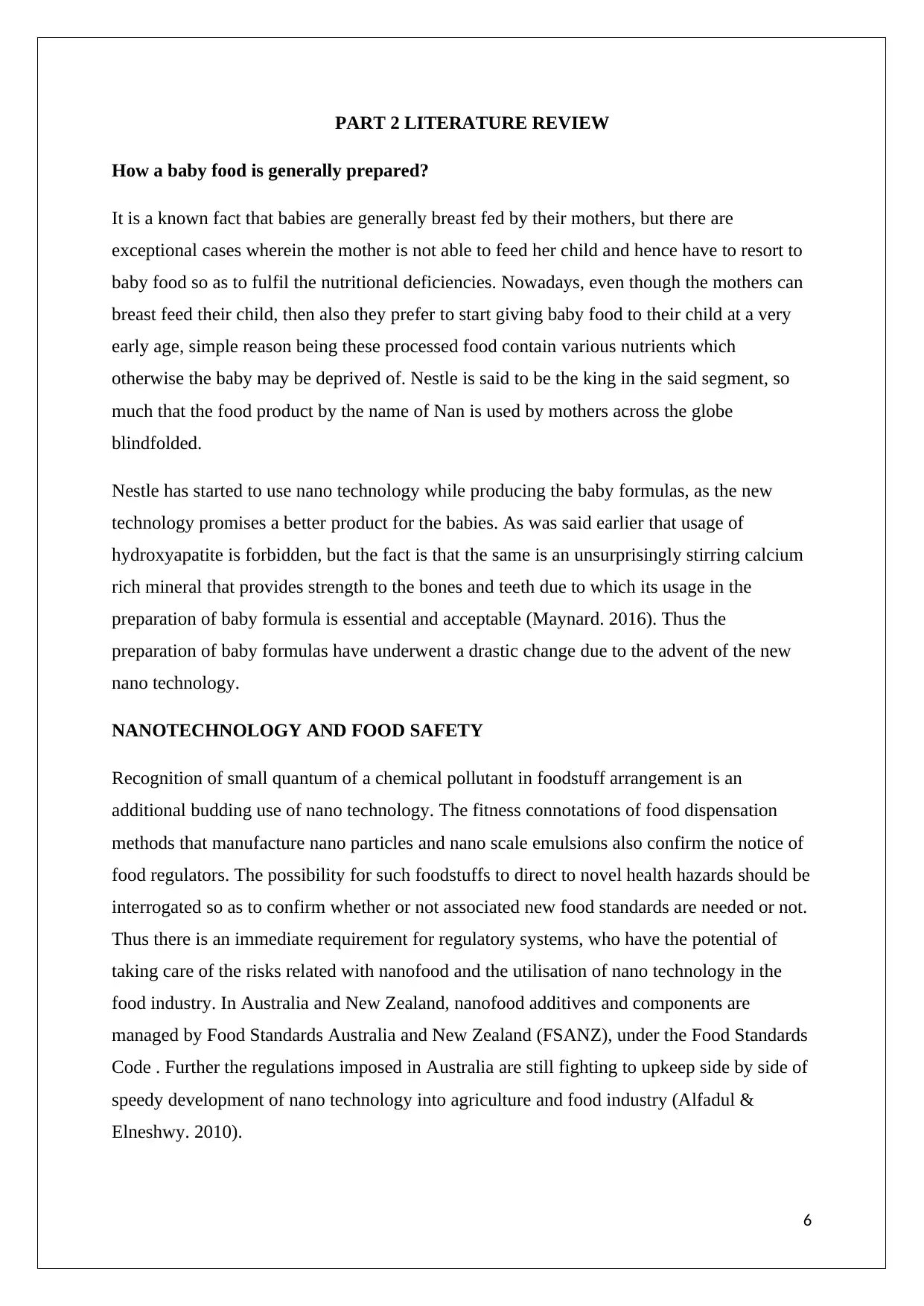
PART 2 LITERATURE REVIEW
How a baby food is generally prepared?
It is a known fact that babies are generally breast fed by their mothers, but there are
exceptional cases wherein the mother is not able to feed her child and hence have to resort to
baby food so as to fulfil the nutritional deficiencies. Nowadays, even though the mothers can
breast feed their child, then also they prefer to start giving baby food to their child at a very
early age, simple reason being these processed food contain various nutrients which
otherwise the baby may be deprived of. Nestle is said to be the king in the said segment, so
much that the food product by the name of Nan is used by mothers across the globe
blindfolded.
Nestle has started to use nano technology while producing the baby formulas, as the new
technology promises a better product for the babies. As was said earlier that usage of
hydroxyapatite is forbidden, but the fact is that the same is an unsurprisingly stirring calcium
rich mineral that provides strength to the bones and teeth due to which its usage in the
preparation of baby formula is essential and acceptable (Maynard. 2016). Thus the
preparation of baby formulas have underwent a drastic change due to the advent of the new
nano technology.
NANOTECHNOLOGY AND FOOD SAFETY
Recognition of small quantum of a chemical pollutant in foodstuff arrangement is an
additional budding use of nano technology. The fitness connotations of food dispensation
methods that manufacture nano particles and nano scale emulsions also confirm the notice of
food regulators. The possibility for such foodstuffs to direct to novel health hazards should be
interrogated so as to confirm whether or not associated new food standards are needed or not.
Thus there is an immediate requirement for regulatory systems, who have the potential of
taking care of the risks related with nanofood and the utilisation of nano technology in the
food industry. In Australia and New Zealand, nanofood additives and components are
managed by Food Standards Australia and New Zealand (FSANZ), under the Food Standards
Code . Further the regulations imposed in Australia are still fighting to upkeep side by side of
speedy development of nano technology into agriculture and food industry (Alfadul &
Elneshwy. 2010).
6
How a baby food is generally prepared?
It is a known fact that babies are generally breast fed by their mothers, but there are
exceptional cases wherein the mother is not able to feed her child and hence have to resort to
baby food so as to fulfil the nutritional deficiencies. Nowadays, even though the mothers can
breast feed their child, then also they prefer to start giving baby food to their child at a very
early age, simple reason being these processed food contain various nutrients which
otherwise the baby may be deprived of. Nestle is said to be the king in the said segment, so
much that the food product by the name of Nan is used by mothers across the globe
blindfolded.
Nestle has started to use nano technology while producing the baby formulas, as the new
technology promises a better product for the babies. As was said earlier that usage of
hydroxyapatite is forbidden, but the fact is that the same is an unsurprisingly stirring calcium
rich mineral that provides strength to the bones and teeth due to which its usage in the
preparation of baby formula is essential and acceptable (Maynard. 2016). Thus the
preparation of baby formulas have underwent a drastic change due to the advent of the new
nano technology.
NANOTECHNOLOGY AND FOOD SAFETY
Recognition of small quantum of a chemical pollutant in foodstuff arrangement is an
additional budding use of nano technology. The fitness connotations of food dispensation
methods that manufacture nano particles and nano scale emulsions also confirm the notice of
food regulators. The possibility for such foodstuffs to direct to novel health hazards should be
interrogated so as to confirm whether or not associated new food standards are needed or not.
Thus there is an immediate requirement for regulatory systems, who have the potential of
taking care of the risks related with nanofood and the utilisation of nano technology in the
food industry. In Australia and New Zealand, nanofood additives and components are
managed by Food Standards Australia and New Zealand (FSANZ), under the Food Standards
Code . Further the regulations imposed in Australia are still fighting to upkeep side by side of
speedy development of nano technology into agriculture and food industry (Alfadul &
Elneshwy. 2010).
6
⊘ This is a preview!⊘
Do you want full access?
Subscribe today to unlock all pages.

Trusted by 1+ million students worldwide
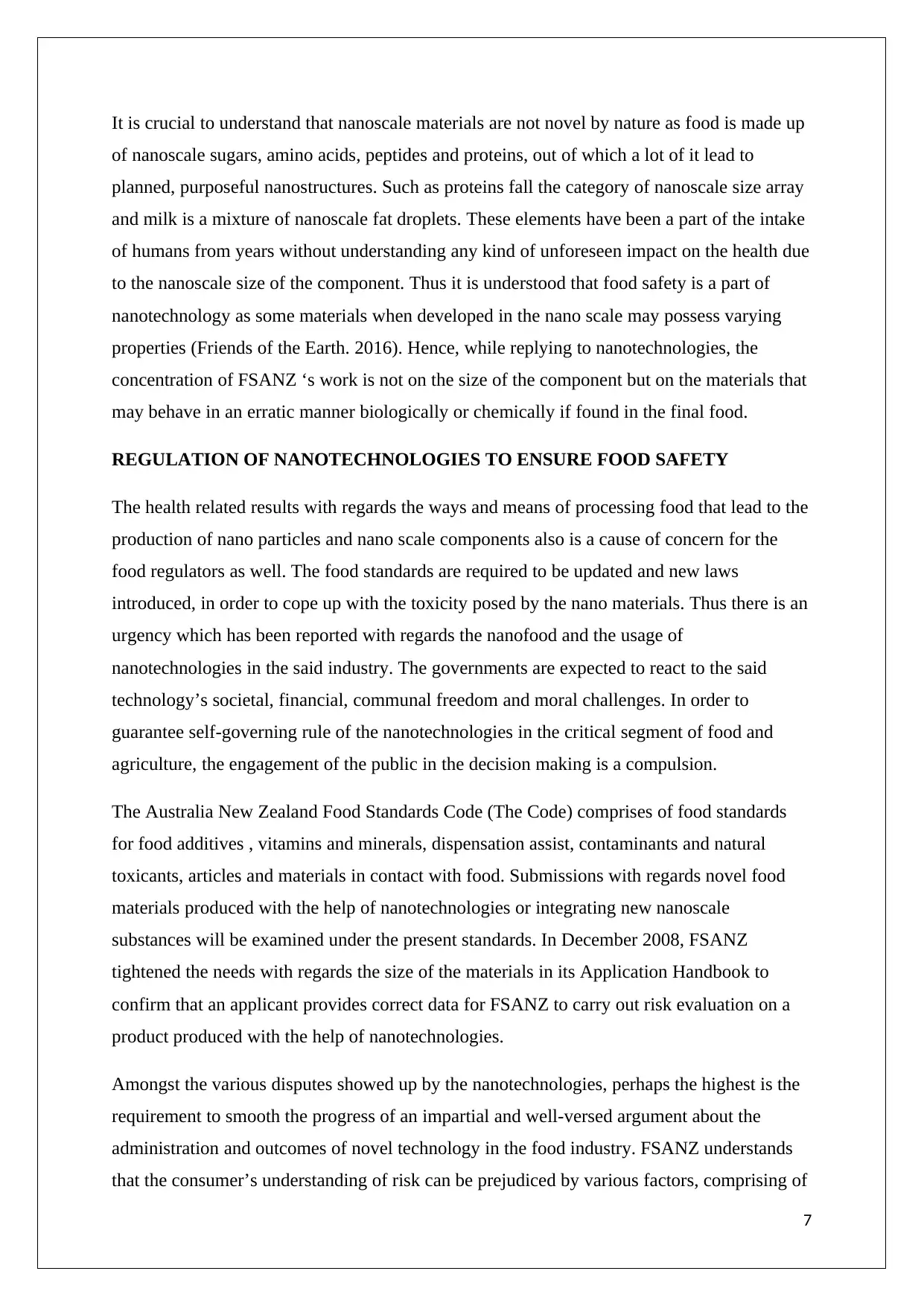
It is crucial to understand that nanoscale materials are not novel by nature as food is made up
of nanoscale sugars, amino acids, peptides and proteins, out of which a lot of it lead to
planned, purposeful nanostructures. Such as proteins fall the category of nanoscale size array
and milk is a mixture of nanoscale fat droplets. These elements have been a part of the intake
of humans from years without understanding any kind of unforeseen impact on the health due
to the nanoscale size of the component. Thus it is understood that food safety is a part of
nanotechnology as some materials when developed in the nano scale may possess varying
properties (Friends of the Earth. 2016). Hence, while replying to nanotechnologies, the
concentration of FSANZ ‘s work is not on the size of the component but on the materials that
may behave in an erratic manner biologically or chemically if found in the final food.
REGULATION OF NANOTECHNOLOGIES TO ENSURE FOOD SAFETY
The health related results with regards the ways and means of processing food that lead to the
production of nano particles and nano scale components also is a cause of concern for the
food regulators as well. The food standards are required to be updated and new laws
introduced, in order to cope up with the toxicity posed by the nano materials. Thus there is an
urgency which has been reported with regards the nanofood and the usage of
nanotechnologies in the said industry. The governments are expected to react to the said
technology’s societal, financial, communal freedom and moral challenges. In order to
guarantee self-governing rule of the nanotechnologies in the critical segment of food and
agriculture, the engagement of the public in the decision making is a compulsion.
The Australia New Zealand Food Standards Code (The Code) comprises of food standards
for food additives , vitamins and minerals, dispensation assist, contaminants and natural
toxicants, articles and materials in contact with food. Submissions with regards novel food
materials produced with the help of nanotechnologies or integrating new nanoscale
substances will be examined under the present standards. In December 2008, FSANZ
tightened the needs with regards the size of the materials in its Application Handbook to
confirm that an applicant provides correct data for FSANZ to carry out risk evaluation on a
product produced with the help of nanotechnologies.
Amongst the various disputes showed up by the nanotechnologies, perhaps the highest is the
requirement to smooth the progress of an impartial and well-versed argument about the
administration and outcomes of novel technology in the food industry. FSANZ understands
that the consumer’s understanding of risk can be prejudiced by various factors, comprising of
7
of nanoscale sugars, amino acids, peptides and proteins, out of which a lot of it lead to
planned, purposeful nanostructures. Such as proteins fall the category of nanoscale size array
and milk is a mixture of nanoscale fat droplets. These elements have been a part of the intake
of humans from years without understanding any kind of unforeseen impact on the health due
to the nanoscale size of the component. Thus it is understood that food safety is a part of
nanotechnology as some materials when developed in the nano scale may possess varying
properties (Friends of the Earth. 2016). Hence, while replying to nanotechnologies, the
concentration of FSANZ ‘s work is not on the size of the component but on the materials that
may behave in an erratic manner biologically or chemically if found in the final food.
REGULATION OF NANOTECHNOLOGIES TO ENSURE FOOD SAFETY
The health related results with regards the ways and means of processing food that lead to the
production of nano particles and nano scale components also is a cause of concern for the
food regulators as well. The food standards are required to be updated and new laws
introduced, in order to cope up with the toxicity posed by the nano materials. Thus there is an
urgency which has been reported with regards the nanofood and the usage of
nanotechnologies in the said industry. The governments are expected to react to the said
technology’s societal, financial, communal freedom and moral challenges. In order to
guarantee self-governing rule of the nanotechnologies in the critical segment of food and
agriculture, the engagement of the public in the decision making is a compulsion.
The Australia New Zealand Food Standards Code (The Code) comprises of food standards
for food additives , vitamins and minerals, dispensation assist, contaminants and natural
toxicants, articles and materials in contact with food. Submissions with regards novel food
materials produced with the help of nanotechnologies or integrating new nanoscale
substances will be examined under the present standards. In December 2008, FSANZ
tightened the needs with regards the size of the materials in its Application Handbook to
confirm that an applicant provides correct data for FSANZ to carry out risk evaluation on a
product produced with the help of nanotechnologies.
Amongst the various disputes showed up by the nanotechnologies, perhaps the highest is the
requirement to smooth the progress of an impartial and well-versed argument about the
administration and outcomes of novel technology in the food industry. FSANZ understands
that the consumer’s understanding of risk can be prejudiced by various factors, comprising of
7
Paraphrase This Document
Need a fresh take? Get an instant paraphrase of this document with our AI Paraphraser
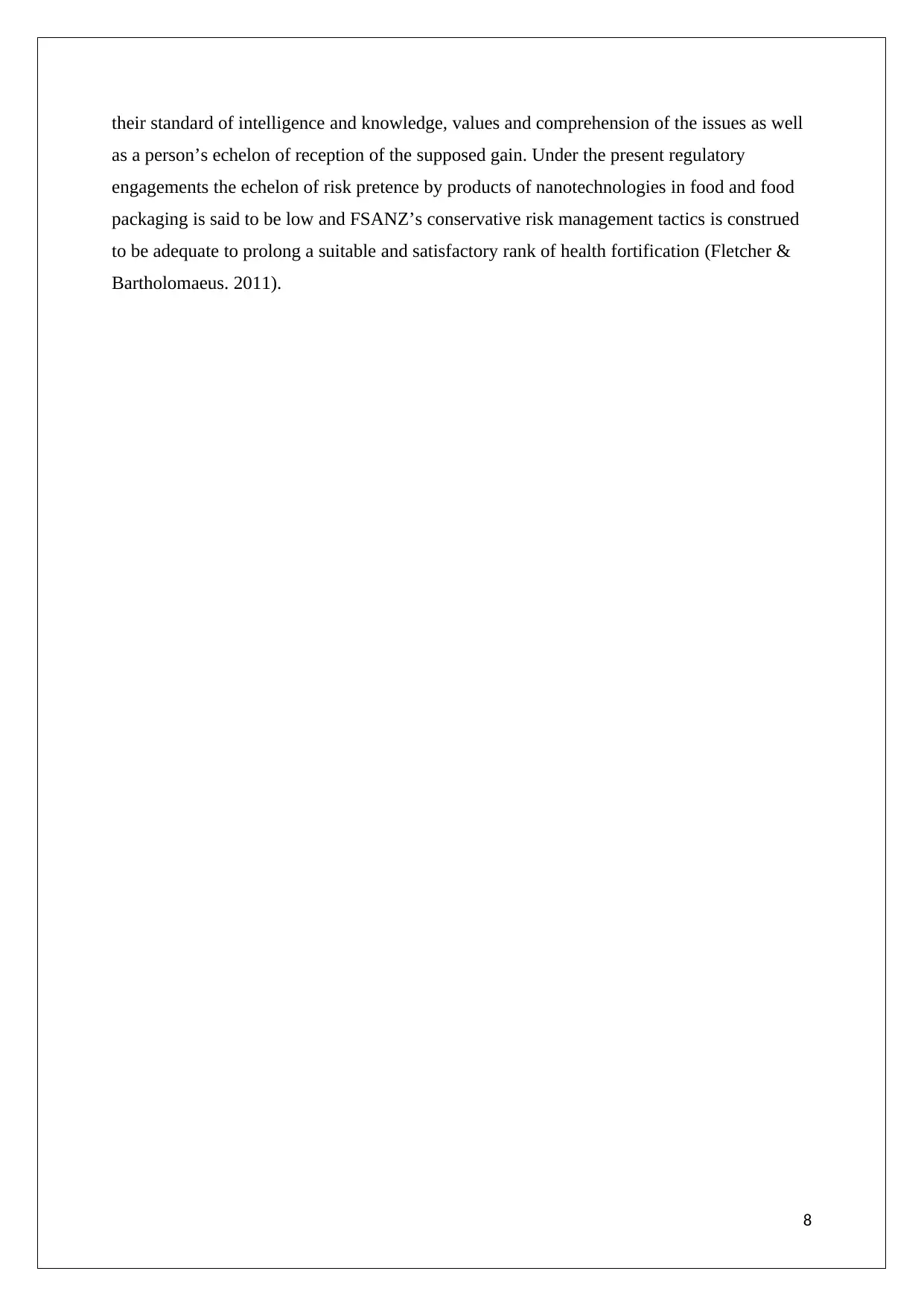
their standard of intelligence and knowledge, values and comprehension of the issues as well
as a person’s echelon of reception of the supposed gain. Under the present regulatory
engagements the echelon of risk pretence by products of nanotechnologies in food and food
packaging is said to be low and FSANZ’s conservative risk management tactics is construed
to be adequate to prolong a suitable and satisfactory rank of health fortification (Fletcher &
Bartholomaeus. 2011).
8
as a person’s echelon of reception of the supposed gain. Under the present regulatory
engagements the echelon of risk pretence by products of nanotechnologies in food and food
packaging is said to be low and FSANZ’s conservative risk management tactics is construed
to be adequate to prolong a suitable and satisfactory rank of health fortification (Fletcher &
Bartholomaeus. 2011).
8
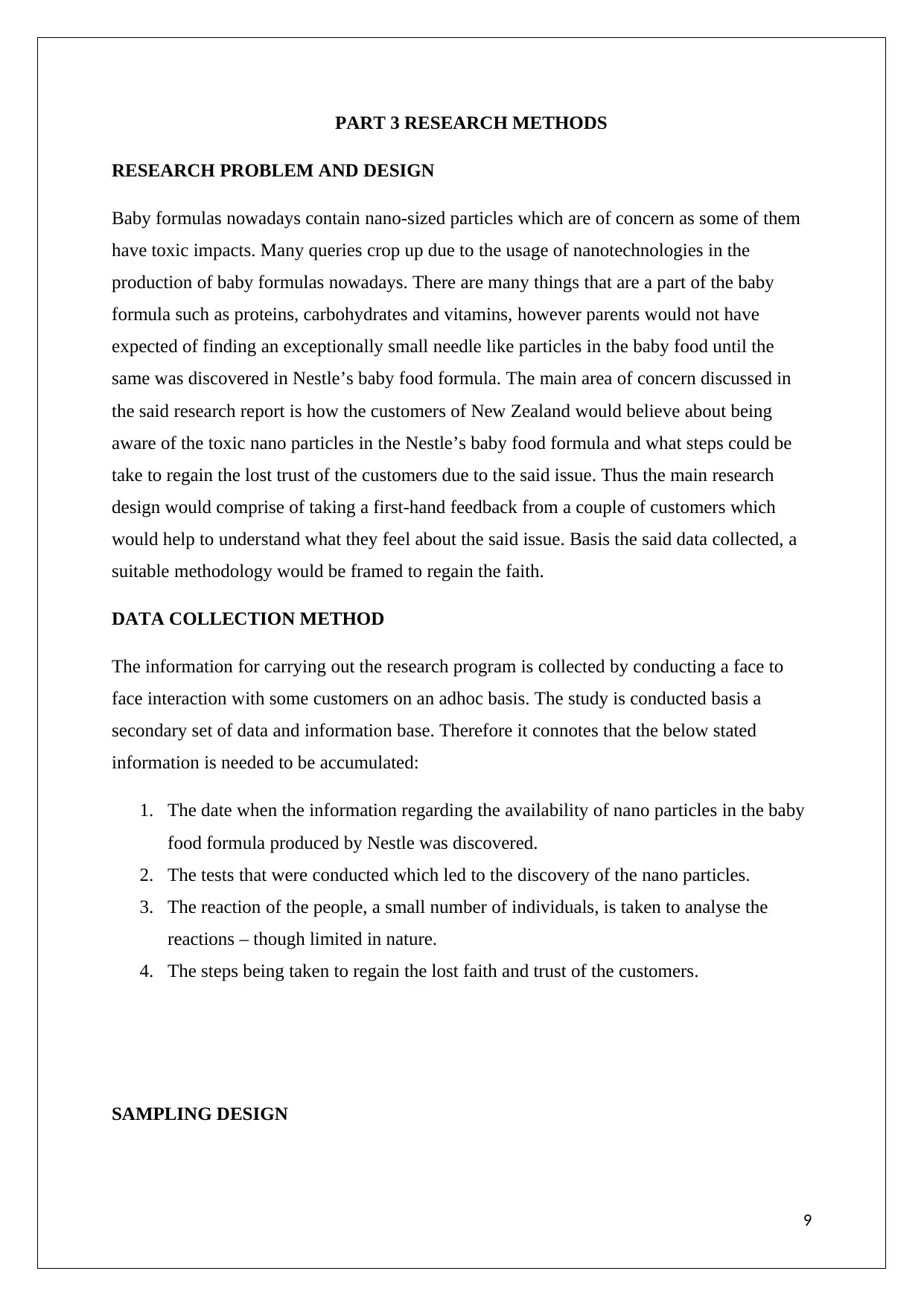
PART 3 RESEARCH METHODS
RESEARCH PROBLEM AND DESIGN
Baby formulas nowadays contain nano-sized particles which are of concern as some of them
have toxic impacts. Many queries crop up due to the usage of nanotechnologies in the
production of baby formulas nowadays. There are many things that are a part of the baby
formula such as proteins, carbohydrates and vitamins, however parents would not have
expected of finding an exceptionally small needle like particles in the baby food until the
same was discovered in Nestle’s baby food formula. The main area of concern discussed in
the said research report is how the customers of New Zealand would believe about being
aware of the toxic nano particles in the Nestle’s baby food formula and what steps could be
take to regain the lost trust of the customers due to the said issue. Thus the main research
design would comprise of taking a first-hand feedback from a couple of customers which
would help to understand what they feel about the said issue. Basis the said data collected, a
suitable methodology would be framed to regain the faith.
DATA COLLECTION METHOD
The information for carrying out the research program is collected by conducting a face to
face interaction with some customers on an adhoc basis. The study is conducted basis a
secondary set of data and information base. Therefore it connotes that the below stated
information is needed to be accumulated:
1. The date when the information regarding the availability of nano particles in the baby
food formula produced by Nestle was discovered.
2. The tests that were conducted which led to the discovery of the nano particles.
3. The reaction of the people, a small number of individuals, is taken to analyse the
reactions – though limited in nature.
4. The steps being taken to regain the lost faith and trust of the customers.
SAMPLING DESIGN
9
RESEARCH PROBLEM AND DESIGN
Baby formulas nowadays contain nano-sized particles which are of concern as some of them
have toxic impacts. Many queries crop up due to the usage of nanotechnologies in the
production of baby formulas nowadays. There are many things that are a part of the baby
formula such as proteins, carbohydrates and vitamins, however parents would not have
expected of finding an exceptionally small needle like particles in the baby food until the
same was discovered in Nestle’s baby food formula. The main area of concern discussed in
the said research report is how the customers of New Zealand would believe about being
aware of the toxic nano particles in the Nestle’s baby food formula and what steps could be
take to regain the lost trust of the customers due to the said issue. Thus the main research
design would comprise of taking a first-hand feedback from a couple of customers which
would help to understand what they feel about the said issue. Basis the said data collected, a
suitable methodology would be framed to regain the faith.
DATA COLLECTION METHOD
The information for carrying out the research program is collected by conducting a face to
face interaction with some customers on an adhoc basis. The study is conducted basis a
secondary set of data and information base. Therefore it connotes that the below stated
information is needed to be accumulated:
1. The date when the information regarding the availability of nano particles in the baby
food formula produced by Nestle was discovered.
2. The tests that were conducted which led to the discovery of the nano particles.
3. The reaction of the people, a small number of individuals, is taken to analyse the
reactions – though limited in nature.
4. The steps being taken to regain the lost faith and trust of the customers.
SAMPLING DESIGN
9
⊘ This is a preview!⊘
Do you want full access?
Subscribe today to unlock all pages.

Trusted by 1+ million students worldwide
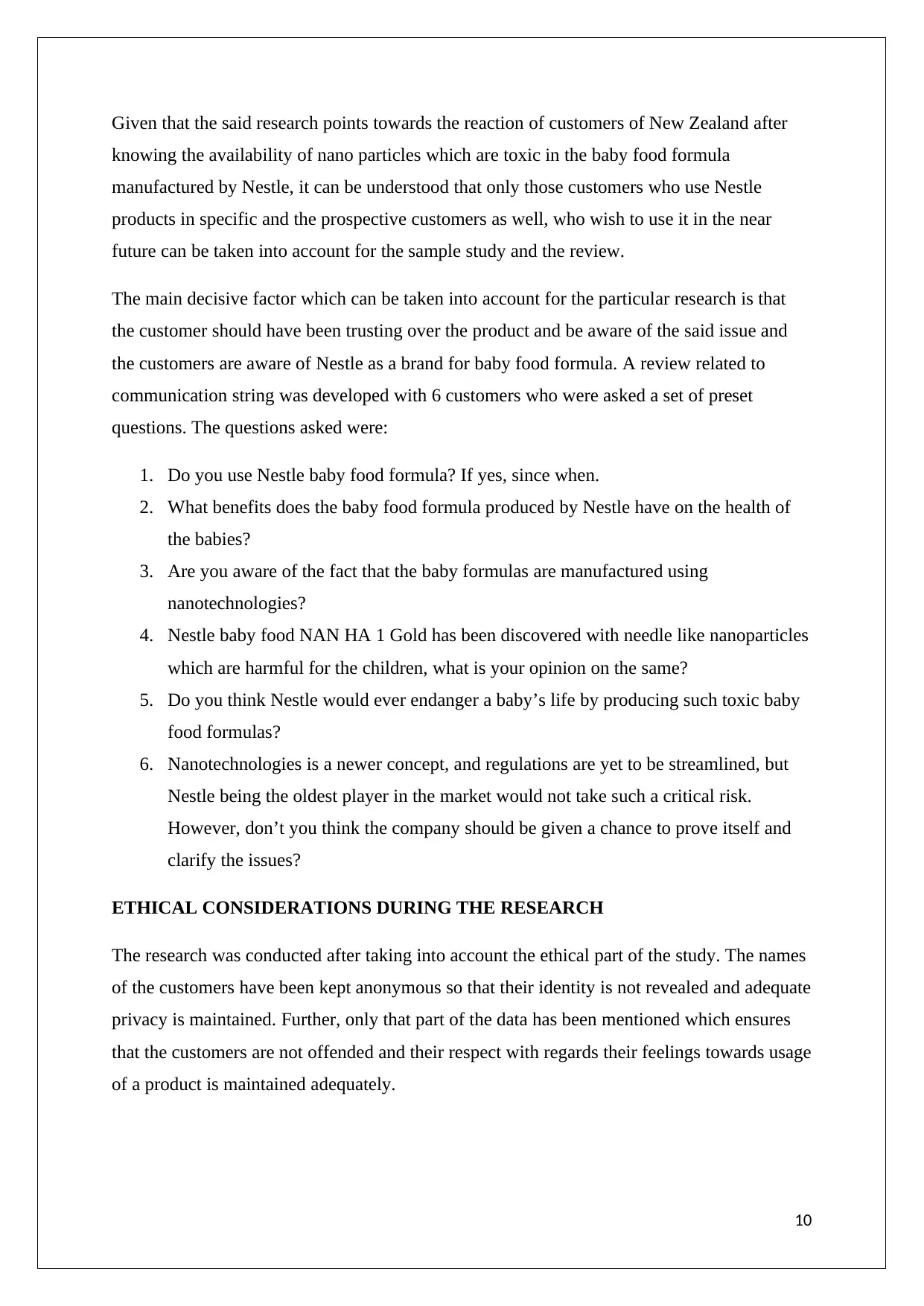
Given that the said research points towards the reaction of customers of New Zealand after
knowing the availability of nano particles which are toxic in the baby food formula
manufactured by Nestle, it can be understood that only those customers who use Nestle
products in specific and the prospective customers as well, who wish to use it in the near
future can be taken into account for the sample study and the review.
The main decisive factor which can be taken into account for the particular research is that
the customer should have been trusting over the product and be aware of the said issue and
the customers are aware of Nestle as a brand for baby food formula. A review related to
communication string was developed with 6 customers who were asked a set of preset
questions. The questions asked were:
1. Do you use Nestle baby food formula? If yes, since when.
2. What benefits does the baby food formula produced by Nestle have on the health of
the babies?
3. Are you aware of the fact that the baby formulas are manufactured using
nanotechnologies?
4. Nestle baby food NAN HA 1 Gold has been discovered with needle like nanoparticles
which are harmful for the children, what is your opinion on the same?
5. Do you think Nestle would ever endanger a baby’s life by producing such toxic baby
food formulas?
6. Nanotechnologies is a newer concept, and regulations are yet to be streamlined, but
Nestle being the oldest player in the market would not take such a critical risk.
However, don’t you think the company should be given a chance to prove itself and
clarify the issues?
ETHICAL CONSIDERATIONS DURING THE RESEARCH
The research was conducted after taking into account the ethical part of the study. The names
of the customers have been kept anonymous so that their identity is not revealed and adequate
privacy is maintained. Further, only that part of the data has been mentioned which ensures
that the customers are not offended and their respect with regards their feelings towards usage
of a product is maintained adequately.
10
knowing the availability of nano particles which are toxic in the baby food formula
manufactured by Nestle, it can be understood that only those customers who use Nestle
products in specific and the prospective customers as well, who wish to use it in the near
future can be taken into account for the sample study and the review.
The main decisive factor which can be taken into account for the particular research is that
the customer should have been trusting over the product and be aware of the said issue and
the customers are aware of Nestle as a brand for baby food formula. A review related to
communication string was developed with 6 customers who were asked a set of preset
questions. The questions asked were:
1. Do you use Nestle baby food formula? If yes, since when.
2. What benefits does the baby food formula produced by Nestle have on the health of
the babies?
3. Are you aware of the fact that the baby formulas are manufactured using
nanotechnologies?
4. Nestle baby food NAN HA 1 Gold has been discovered with needle like nanoparticles
which are harmful for the children, what is your opinion on the same?
5. Do you think Nestle would ever endanger a baby’s life by producing such toxic baby
food formulas?
6. Nanotechnologies is a newer concept, and regulations are yet to be streamlined, but
Nestle being the oldest player in the market would not take such a critical risk.
However, don’t you think the company should be given a chance to prove itself and
clarify the issues?
ETHICAL CONSIDERATIONS DURING THE RESEARCH
The research was conducted after taking into account the ethical part of the study. The names
of the customers have been kept anonymous so that their identity is not revealed and adequate
privacy is maintained. Further, only that part of the data has been mentioned which ensures
that the customers are not offended and their respect with regards their feelings towards usage
of a product is maintained adequately.
10
Paraphrase This Document
Need a fresh take? Get an instant paraphrase of this document with our AI Paraphraser
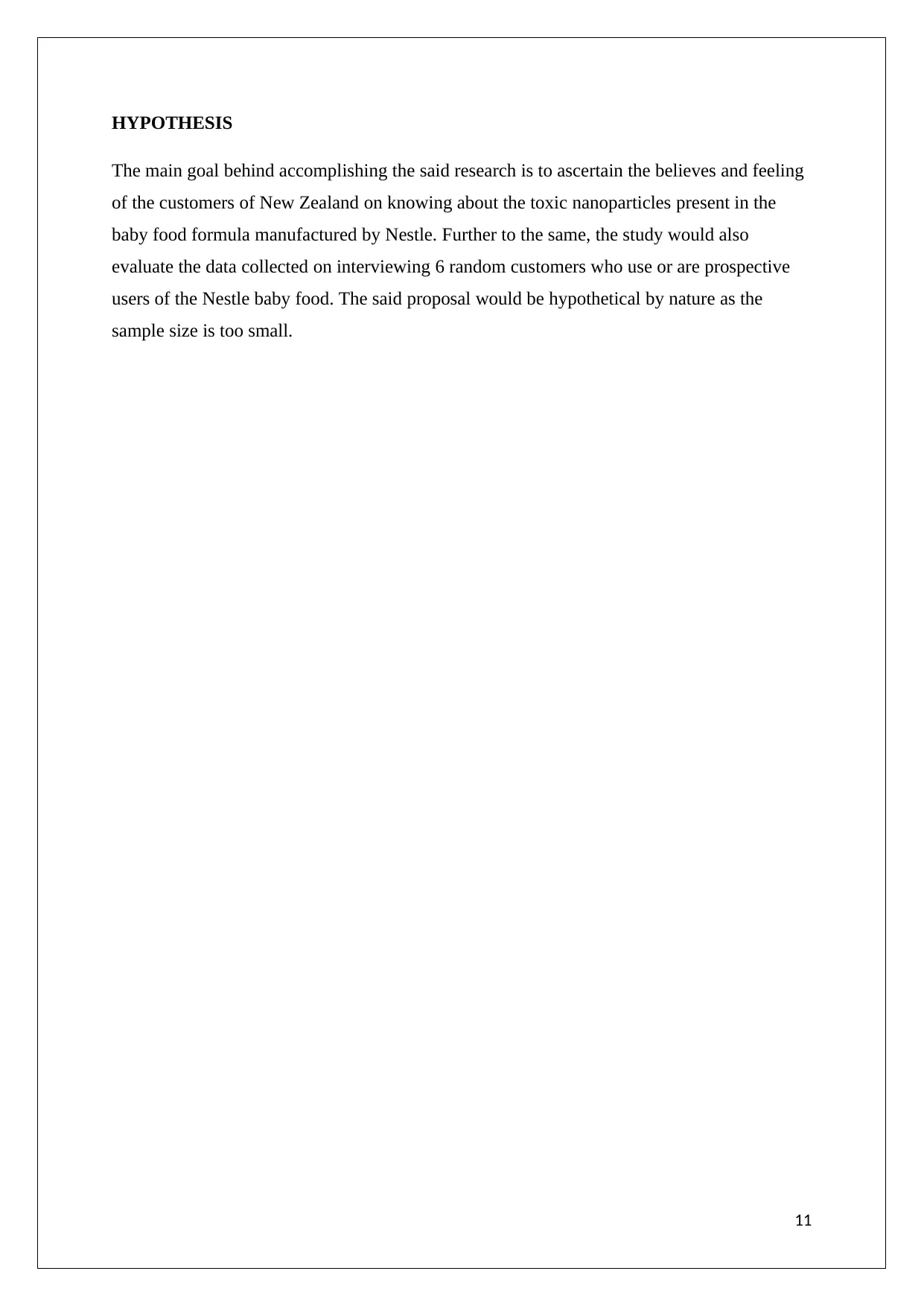
HYPOTHESIS
The main goal behind accomplishing the said research is to ascertain the believes and feeling
of the customers of New Zealand on knowing about the toxic nanoparticles present in the
baby food formula manufactured by Nestle. Further to the same, the study would also
evaluate the data collected on interviewing 6 random customers who use or are prospective
users of the Nestle baby food. The said proposal would be hypothetical by nature as the
sample size is too small.
11
The main goal behind accomplishing the said research is to ascertain the believes and feeling
of the customers of New Zealand on knowing about the toxic nanoparticles present in the
baby food formula manufactured by Nestle. Further to the same, the study would also
evaluate the data collected on interviewing 6 random customers who use or are prospective
users of the Nestle baby food. The said proposal would be hypothetical by nature as the
sample size is too small.
11
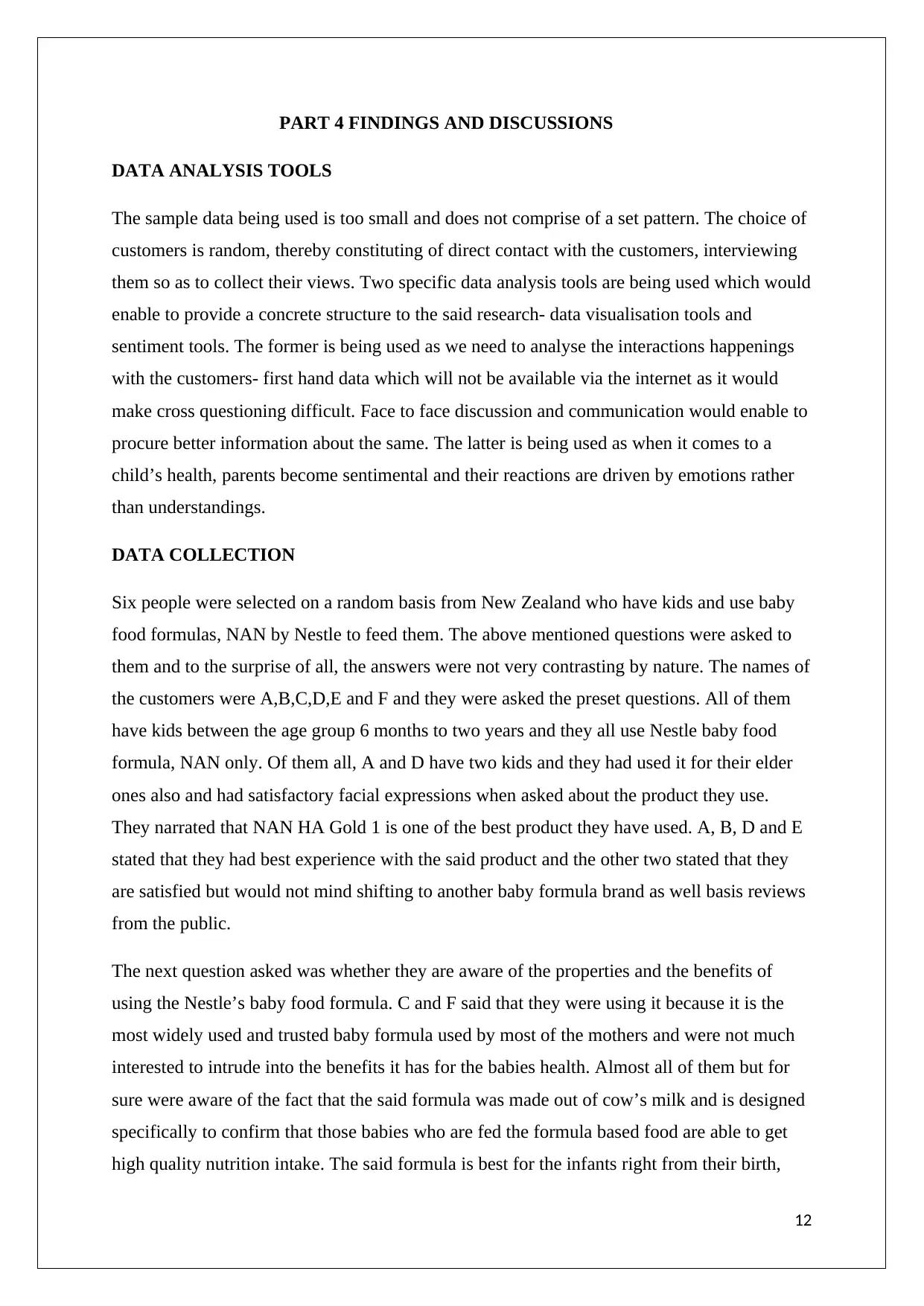
PART 4 FINDINGS AND DISCUSSIONS
DATA ANALYSIS TOOLS
The sample data being used is too small and does not comprise of a set pattern. The choice of
customers is random, thereby constituting of direct contact with the customers, interviewing
them so as to collect their views. Two specific data analysis tools are being used which would
enable to provide a concrete structure to the said research- data visualisation tools and
sentiment tools. The former is being used as we need to analyse the interactions happenings
with the customers- first hand data which will not be available via the internet as it would
make cross questioning difficult. Face to face discussion and communication would enable to
procure better information about the same. The latter is being used as when it comes to a
child’s health, parents become sentimental and their reactions are driven by emotions rather
than understandings.
DATA COLLECTION
Six people were selected on a random basis from New Zealand who have kids and use baby
food formulas, NAN by Nestle to feed them. The above mentioned questions were asked to
them and to the surprise of all, the answers were not very contrasting by nature. The names of
the customers were A,B,C,D,E and F and they were asked the preset questions. All of them
have kids between the age group 6 months to two years and they all use Nestle baby food
formula, NAN only. Of them all, A and D have two kids and they had used it for their elder
ones also and had satisfactory facial expressions when asked about the product they use.
They narrated that NAN HA Gold 1 is one of the best product they have used. A, B, D and E
stated that they had best experience with the said product and the other two stated that they
are satisfied but would not mind shifting to another baby formula brand as well basis reviews
from the public.
The next question asked was whether they are aware of the properties and the benefits of
using the Nestle’s baby food formula. C and F said that they were using it because it is the
most widely used and trusted baby formula used by most of the mothers and were not much
interested to intrude into the benefits it has for the babies health. Almost all of them but for
sure were aware of the fact that the said formula was made out of cow’s milk and is designed
specifically to confirm that those babies who are fed the formula based food are able to get
high quality nutrition intake. The said formula is best for the infants right from their birth,
12
DATA ANALYSIS TOOLS
The sample data being used is too small and does not comprise of a set pattern. The choice of
customers is random, thereby constituting of direct contact with the customers, interviewing
them so as to collect their views. Two specific data analysis tools are being used which would
enable to provide a concrete structure to the said research- data visualisation tools and
sentiment tools. The former is being used as we need to analyse the interactions happenings
with the customers- first hand data which will not be available via the internet as it would
make cross questioning difficult. Face to face discussion and communication would enable to
procure better information about the same. The latter is being used as when it comes to a
child’s health, parents become sentimental and their reactions are driven by emotions rather
than understandings.
DATA COLLECTION
Six people were selected on a random basis from New Zealand who have kids and use baby
food formulas, NAN by Nestle to feed them. The above mentioned questions were asked to
them and to the surprise of all, the answers were not very contrasting by nature. The names of
the customers were A,B,C,D,E and F and they were asked the preset questions. All of them
have kids between the age group 6 months to two years and they all use Nestle baby food
formula, NAN only. Of them all, A and D have two kids and they had used it for their elder
ones also and had satisfactory facial expressions when asked about the product they use.
They narrated that NAN HA Gold 1 is one of the best product they have used. A, B, D and E
stated that they had best experience with the said product and the other two stated that they
are satisfied but would not mind shifting to another baby formula brand as well basis reviews
from the public.
The next question asked was whether they are aware of the properties and the benefits of
using the Nestle’s baby food formula. C and F said that they were using it because it is the
most widely used and trusted baby formula used by most of the mothers and were not much
interested to intrude into the benefits it has for the babies health. Almost all of them but for
sure were aware of the fact that the said formula was made out of cow’s milk and is designed
specifically to confirm that those babies who are fed the formula based food are able to get
high quality nutrition intake. The said formula is best for the infants right from their birth,
12
⊘ This is a preview!⊘
Do you want full access?
Subscribe today to unlock all pages.

Trusted by 1+ million students worldwide
1 out of 22
Related Documents
Your All-in-One AI-Powered Toolkit for Academic Success.
+13062052269
info@desklib.com
Available 24*7 on WhatsApp / Email
![[object Object]](/_next/static/media/star-bottom.7253800d.svg)
Unlock your academic potential
Copyright © 2020–2025 A2Z Services. All Rights Reserved. Developed and managed by ZUCOL.



